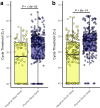Longitudinal analysis of built environment and aerosol contamination associated with isolated COVID-19 positive individuals
- PMID: 35513399
- PMCID: PMC9070971
- DOI: 10.1038/s41598-022-11303-8
Longitudinal analysis of built environment and aerosol contamination associated with isolated COVID-19 positive individuals
Abstract
The indoor environment is the primary location for the transmission of severe acute respiratory syndrome coronavirus 2 (SARS-CoV-2), the causative agent of coronavirus disease 2019 (COVID-19), largely driven by respiratory particle accumulation in the air and increased connectivity between the individuals occupying indoor spaces. In this study, we aimed to track a cohort of subjects as they occupied a COVID-19 isolation dormitory to better understand the impact of subject and environmental viral load over time, symptoms, and room ventilation on the detectable viral load within a single room. We find that subject samples demonstrate a decrease in overall viral load over time, symptoms significantly impact environmental viral load, and we provide the first real-world evidence for decreased aerosol SARS-CoV-2 load with increasing ventilation, both from mechanical and window sources. These results may guide environmental viral surveillance strategies and be used to better control the spread of SARS-CoV-2 within built environments and better protect those caring for individuals with COVID-19.
© 2022. The Author(s).
Conflict of interest statement
KGVDW has a company called Duktile through which he provides healthy building consulting, including consulting related to viral pathogens, and he serves as a scientific advisor to EnviralTech and Poppy, companies that conduct viral surveillance. No other authors have any competing interests to declare.
Figures






References
-
- National Academies of Sciences, Engineering, and Medicine et al. The Built Environment and Microbial Communities. (National Academies Press (US), 2017).
-
- Naming the coronavirus disease (COVID-19) and the virus that causes it. https://www.who.int/emergencies/diseases/novel-coronavirus-2019/technica.... Accessed on 10 August 2021
Publication types
MeSH terms
Substances
LinkOut - more resources
Full Text Sources
Medical
Miscellaneous

